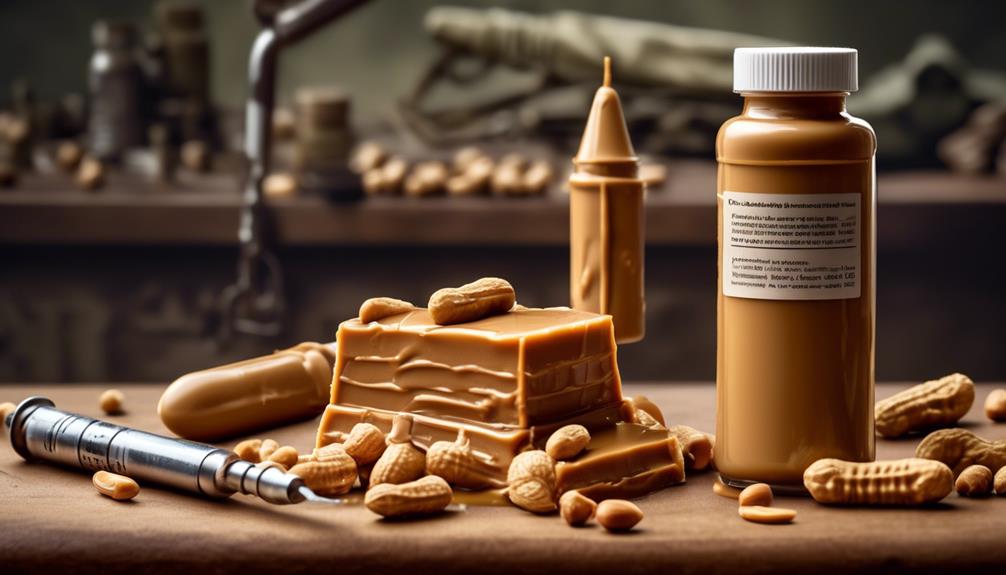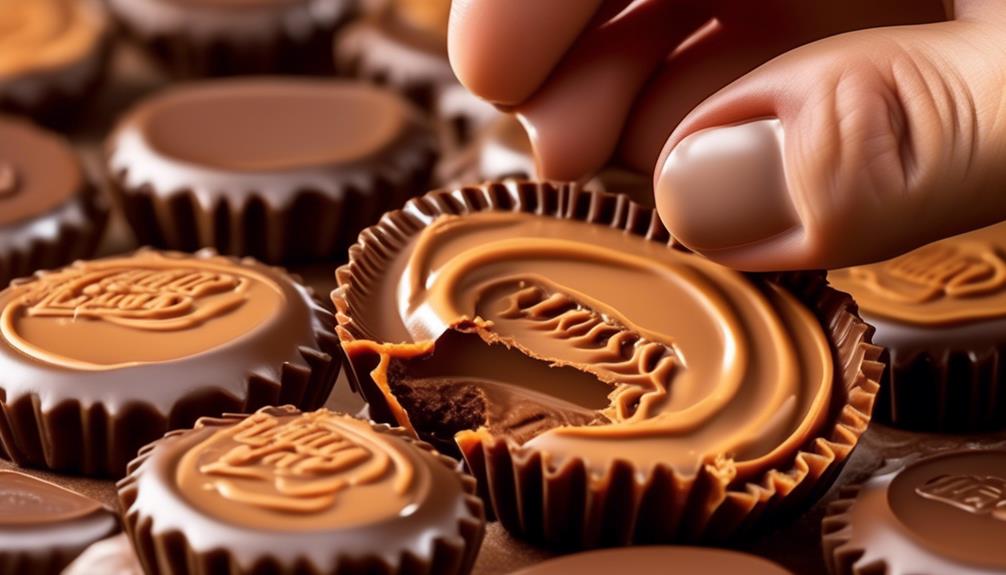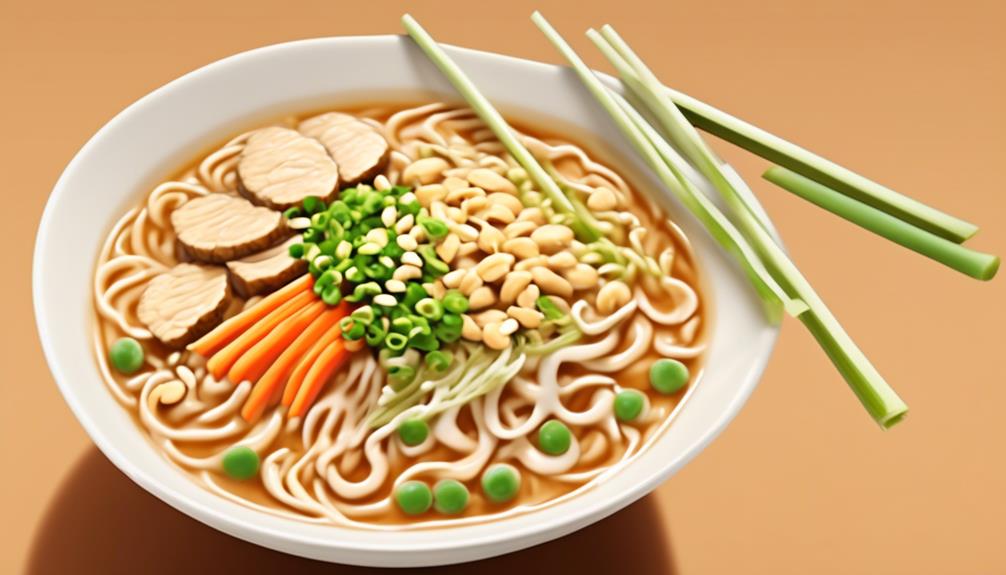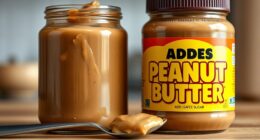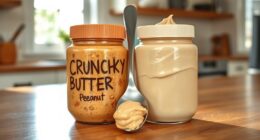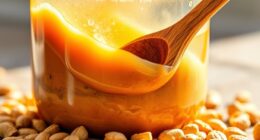The saying goes: ‘The proof is in the pudding.’
Have you ever wondered why they call it the peanut butter shot? It's a nickname that has sparked curiosity and even a bit of dread among those who have experienced it.
But what exactly is the peanut butter shot, and why does it have such a distinctive moniker? Let's unpack the origins of this nickname and explore the composition, purpose, and perception of this particular vaccine.
There's more to it than meets the eye, and understanding the reasons behind the name might just change the way you think about it.
Key Takeaways
- The nickname "peanut butter shot" originated from the thick, peanut butter-like consistency of the medication administered during military training.
- The peanut butter shot contains penicillin G benzathine and is designed to provide broad-spectrum protection against bacterial infections.
- The shot is administered to nearly every recruit, except those with a proven allergy to the medication.
- The slow absorption rate and the formation of a painful lump in the muscle contribute to the discomfort associated with the peanut butter shot.
Origins of the Nickname
The nickname 'peanut butter shot' originated from the thick, peanut butter-like consistency of the medication administered to recruits during military training. This injection, known as bicillin, is a crucial part of the medical evaluations and vaccinations that recruits undergo during boot camp.
The unique appearance and texture of the medication, resembling that of peanut butter, led to the popularization of the nickname. As recruits receive the shot in the butt cheek, the slow absorption of the thick liquid causes discomfort, further cementing the association with peanut butter.
This nickname has become an almighty descriptor for the injection among military personnel due to its distinct appearance and the discomfort it causes. Even though it's a necessary part of the vaccination process, the 'peanut butter shot' moniker persists, highlighting the enduring impact of its origins.
Vaccine Composition and Purpose

The peanut butter shot, also known as the bicillin vaccination, contains penicillin G benzathine and is designed to provide broad-spectrum protection against bacterial infections.
It's slowly released into the muscle over a few days, contributing to its effectiveness.
This vaccination is a crucial measure in safeguarding the health and well-being of military personnel during their training and deployment.
Vaccine Ingredients
Containing penicillin G benzathine, the peanut butter shot is an essential component of military vaccination protocols, aimed at preventing and treating bacterial infections among recruits. The thick liquid is injected into the recruits' butt cheeks, delivering a powerful dose of Bicillin that targets various bacteria strands. Medical staff administers the shot during boot camp, subjecting recruits to excruciating pain but effectively protecting them from potential infections. Recruits receive this shot unless they have a proven allergy to the medication, as it is crucial for preventing the spread of infectious diseases among large groups of individuals in close quarters. The peanut butter shot is a standard vaccination in military training, vital for maintaining the health and safety of military personnel.
| Vaccine Ingredients | Medical Staff | Recruits |
|---|---|---|
| Penicillin G Benzathine | Administers | Receives |
| Bicillin | Injects | Subjected |
| Various Bacteria Strands | Delivers | Protected |
Immunization Process
In our immunization process, the vaccine composition and purpose are crucial aspects that warrant thorough understanding and consideration.
The peanut butter shot, given to military recruits, contains penicillin G benzathine, an antibiotic, to prevent bacterial infections. It's a standard procedure in military medical evaluations and is essential for the health and safety of military personnel.
This vaccination provides broad-spectrum protection against various bacterial strains, ensuring recruits are safeguarded against potential illnesses. The shot is administered to nearly every recruit, except those with a proven allergy to the medication.
Understanding the composition and purpose of this famous shot is essential for recruits, as it plays a vital role in keeping them healthy during their long training process.
Therefore, the meticulous consideration of vaccine composition and purpose is integral to our immunization process.
Health Benefits
To promote the health and safety of military personnel during basic training, the peanut butter shot contains penicillin G benzathine, an antibiotic, administered to prevent and treat bacterial infections.
This injection serves as an almighty shield, safeguarding recruits from a spectrum of bacterial strains, ensuring their well-being in the rigorous environment of boot camps.
The medication's slow absorption rate provides sustained protection, allowing recruits to engage in rigorous physical movement without compromising their health.
The peanut butter shot stands as a pivotal component of the immunization process, upholding the health and safety of every recruit.
Pain and Discomfort Perception

We understand that pain perception and discomfort experience are significant aspects of receiving the peanut butter shot. The slow absorption rate and the formation of a painful lump in the muscle contribute to the discomfort associated with this vaccination.
It's important to address these factors and understand their impact on the individuals receiving the peanut butter shot.
Pain Perception
Understanding pain perception involves a complex interplay of sensory, emotional, and cognitive components, influencing individuals' responses to discomfort and injury. Pain perception varies widely among people, affected by genetics, previous experiences, and psychological state.
In settings such as military or medical training, the 'peanut butter shot' is notorious for causing intense discomfort. This injection, which contains a thick liquid medication, is administered to recruits and is known for the pain it induces.
The perception of pain can also be influenced by factors such as the anticipation of discomfort, the presence of medical staff during a vaccination, or even intense physical movement.
It's crucial for healthcare professionals to comprehend these nuances in pain perception to provide effective pain management and treatment tailored to individual needs.
Discomfort Experience
Experiencing discomfort, particularly in the context of medical procedures, can significantly impact an individual's physical and emotional well-being.
The peanut butter shot, administered to recruits during boot camp, is known for causing significant discomfort due to its thick liquid and the injection site in the butt cheeks. The pain and slow absorption rate of the medication can lead to physical discomfort and emotional distress among the recruits.
Medical staff are well aware of the discomfort this injection causes and take measures to minimize the pain and support the recruits during this experience. The physical movement associated with the injection and the formation of a painful lump at the injection site can add to the recruits' discomfort.
Despite this discomfort, the peanut butter shot remains an essential preventive measure for recruits, providing them with an introduction to medical challenges they may face in the military.
Cultural and Historical Context

During the mid-20th century, the peanut butter shot, formally known as the bicillin vaccination, became an iconic element of military culture due to its unique and memorable administration process.
- Boot camps require every recruit to receive the thick, peanut butter-like bicillin vaccination unless they've a proven allergy to the medication.
- Adding intense physical movement to the administration process makes the peanut butter shot an unforgettable experience for recruits.
- The peanut butter shot is dreaded due to the pain it causes, resulting in a slow absorption rate and the formation of a painful lump in the injection site.
- The cultural significance of the peanut butter shot lies in its reputation as the most feared and discomforting injection in the military, earning it the nickname 'the Almighty peanut butter.'
The peanut butter shot has become an integral part of military culture, representing the physical and emotional challenges faced by recruits during their training. Its unique administration process has contributed to its notoriety, making it a symbol of the demanding and rigorous nature of military service.
Military Protocol and Administration

Military personnel administer the peanut butter shot to recruits during their medical evaluations in boot camp to prevent bacterial infections. The peanut butter shot, also known as the bicillin vaccination, contains penicillin G benzathine and is given to nearly every recruit. This vaccination is a crucial part of military protocol, as it helps protect recruits from various bacteria strands commonly found in the training environment. Medical staff carefully administer the injection to ensure all recruits are protected from potential infections that could impact their performance during training. Recruits who have proven allergies to the medication receive alternative treatments to safeguard their health. The peanut butter shot, while effective in preventing infections, is known for causing significant pain and discomfort. This can temporarily affect the daily activities of recruits during their intense boot camp training. It is essential for medical staff to closely monitor and manage any potential side effects to ensure the well-being of the recruits.
| Peanut Butter Shot Information | |
|---|---|
| Purpose | Prevent bacterial infections |
| Main Component | Penicillin G benzathine |
| Recruit Considerations | Allergies require alternative treatment |
Public Perception and Misconceptions

Public perception of the peanut butter shot, also known as the bicillin vaccination, often revolves around the discomfort and pain it causes, stemming from its thick, slow-absorbing nature and the subsequent formation of a painful lump in the muscle. However, there are some misconceptions that need to be addressed:
- Misconception: The peanut butter shot is unnecessary and ineffective.
- Fact: The vaccination is crucial in protecting recruits from various bacterial strands, preventing potentially serious illnesses.
- Misconception: Medical staff administering the shot are indifferent to recruits' pain.
- Fact: Medical staff are trained to minimize discomfort and provide necessary care during and after the injection.
- Misconception: Recruits have no alternative but to endure the excruciating pain.
- Fact: Recruits with proven allergies are exempt from receiving the peanut butter shot, and alternative medications or treatments are available.
- Misconception: The pain is just temporary and has no lasting impact.
- Fact: The pain and discomfort caused by the peanut butter shot can affect recruits' daily activities and physical performance during training, warranting consideration and proper management.
It's essential to dispel these misconceptions to ensure a better understanding of the peanut butter shot and its significance in the protection of recruits during their training.
Frequently Asked Questions
Does the Military Still Do the Peanut Butter Shot?
Yes, the military still administers the peanut butter shot as part of the medical evaluations during boot camp. Recruits receive the shot in the butt cheek to prevent bacterial infections.
While it can cause discomfort, it's considered effective in protecting recruits from illnesses. The peanut butter shot, despite its notoriety, remains a standard procedure in military training.
What Is the Peanut Butter Shot Slang?
The peanut butter shot is a nickname for the bicillin vaccination given in the military. It's administered in the butt cheek due to its thick, peanut butter-like consistency. Recruits receive it during boot camp as part of their medical evaluations, unless they've a proven allergy to the medication.
The shot is feared due to the pain it causes, with a slow absorption rate and formation of a painful lump, making it difficult to sit and move for a few days.
Why Does the Military Give Penicillin Shots?
The military gives penicillin shots to prevent the spread of infectious diseases among large groups of recruits during their intense training schedules. It contains penicillin G benzathine, an antibiotic, and is given to nearly every recruit to prevent bacterial infections.
Our goal is to ensure the health and safety of our recruits, and this vaccination is a crucial part of our medical evaluations during boot camp.
How Many Shots Do You Get in Basic Training?
We usually receive several shots during basic training, with each aimed at protecting us from different illnesses. These vaccinations are an important part of ensuring our health and safety.
The peanut butter shot, known for its thick consistency, is just one of the vaccinations given. While it can be painful and cause discomfort, it's a crucial step in preventing bacterial infections.
Conclusion
In conclusion, the 'peanut butter shot' nickname for the vaccine may have originated from its resemblance to the spread and its thick texture. Despite the discomfort it may cause, the vaccine serves a crucial purpose in protecting military personnel from infectious diseases.
So, the next time someone mentions the 'peanut butter shot,' remember its important role in keeping our service members healthy and ask yourself: Can a nickname truly capture the significance of a life-saving vaccine?
